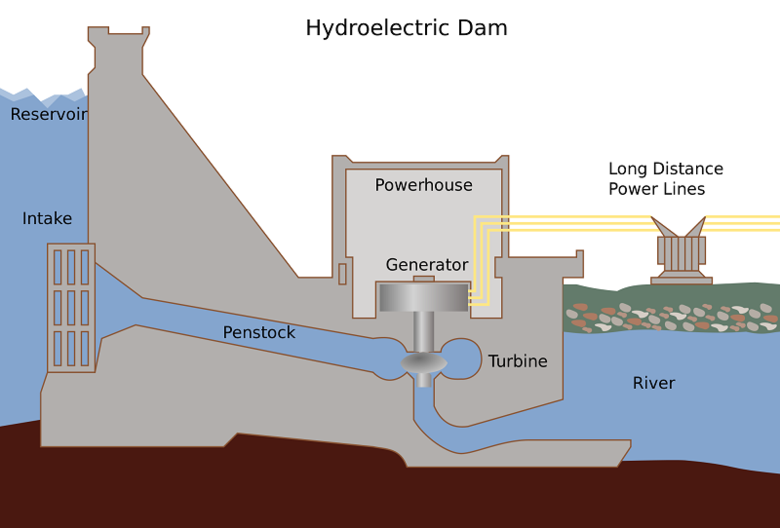Hydroelectric facility
A hydroelectric facility is a special type of power plant that uses the energy of falling or flowing water to generate electricity. They do this by directing water over a series of turbines which convert the potential and kinetic energy of water into the rotational motion of the turbine. The turbine is then attached to a generator and the motion is used to generate electricity. Hydropower provides the world with around 16% of total electric power generation. Some of the largest producers include China, Canada, and Brazil.See world electricity generation for specific details on how much electricity is generated by hydropower in different countries.
A diagram of a conventional hydroelectric facility is shown below.

Types
| Classification | Capacity |
|---|---|
| Large | > 100 MW |
| Medium | 15 - 100 MW |
| Small | 1 - 15 MW |
| Mini | 100 kW - 1 MW |
| Micro | 5 - 100 kW |
| Pico | ~ 200 W - 5 kW |
There are both conventional and unconventional hydroelectric facilities. Conventional hydroelectric facilities - the most common type - rely on a head difference created by man-made dams and obstructions. Two types of systems that are considered conventional are hydroelectric dams and tidal dam. Unconventional generation techniques generally rely on hydroelectric discharge or on a small head differential. Some examples of unconventional hydropower facilities are low head hydro, run-of-the-river systems, instream hydro, and kinetic tidal.
Each type of hydroelectric generation method has an associated output classification based on its capacity. They are outlined in the table to the left.
Components and Operation
Many different factors go into the design of a hydroelectric facility, but most have the same fundamental components and operate in the same general way. These components and their function are outlined below.
Reservoir
- main article
A hydroelectric reservoir is a collection of water held back by a hydroelectric dam. This water has a set amount of potential energy as it is held above the tail race of the dam, and the potential energy is used for generating electricity. The height that the water in the reservoir is at is known as the hydraulic head, and is one of the major factors in determining how much electricity can be generated. The higher the water is, the more potential energy it has and thus the more electricity can be generated.
Dam
- main article
A hydroelectric dam is a large, man-made structure built to contain some body of water. The purpose of a hydroelectric dam is to provide a place to convert the potential and kinetic energy of water to electrical energy by using a turbine and generator. Dams act as the place where water is held back and released in a controlled manner down to these turbines, providing the location for the energy transformations to occur. Typical dams work to create a reservoir where water is stored at a given height. This height and the speed at which the water falls from the reservoir to the turbines determines how much electricity can be generated.
Penstock
- main article
Penstocks are pipes or long channels that carry water down from the hydroelectric reservoir to the turbines inside the actual power station. Generally, they are made of steel and water under high pressure flows through the penstock. They are a vital component of a hydroelectric facility that allows water to move to the turbine. Grates or filters can be attached to the ends of penstocks to trap large debris such as branches. This ensures that debris cannot enter the channel and block it. The amount of water that is allowed to flow through the penstock can be controlled with a sluice, which is simply a gate that can be raised and lowered to increase or decrease the amount of water allowed to flow through.
Turbines
- main article
Hydro turbines are devices used in hydroelectric generation plants that transfer the energy from moving water to a rotating shaft to generate electricity. These turbines rotate or spin as a response to water being introduced to their blades. The type of turbine selected for any given hydropower project is based on the height of the water storage - known as the hydraulic head - and the volume of water that flows known as the flow rate. Efficiency and cost are also factors to be considered.
Efficiency
The energy of moving water is purely mechanical energy, one of the highest-quality forms of energy. So in theory, since it is such a high-quality energy it can be converted to electrical energy with near 100% efficiency as there is no thermal energy involved (and thus the second law of thermodynamics doesn't have to be taken into account). However, there are still minor losses associated with friction and inefficiencies in the transportation of electricity (as a result of factors such as resistance in wires). Overall, this means hydropower can be converted to electricity with efficiencies higher than 90%.
For Further Reading
For further information please see the related pages below:
- Hydropower
- Hydroelectricity
- Hydrologic cycle
- Environmental impacts of hydropower
- Dam failures



